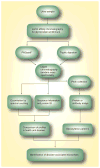Urinary proteomic profiling for diagnostic bladder cancer biomarkers
- PMID: 19811072
- PMCID: PMC3422861
- DOI: 10.1586/epr.09.70
Urinary proteomic profiling for diagnostic bladder cancer biomarkers
Abstract
The ability to detect and monitor bladder cancer in noninvasively obtained urine samples is a major goal. While a number of protein biomarkers have been identified and commercially developed, none have greatly improved the accuracy of sample evaluation over invasive cystoscopy. The ongoing development of high-throughput proteomic profiling technologies will facilitate the identification of molecular signatures that are associated with bladder disease. The appropriate use of these approaches has the potential to provide efficient biomarkers for the early detection and monitoring of recurrent bladder cancer. Identification of disease-associated proteins will also advance our knowledge of tumor biology, which, in turn, will enable development of targeted therapeutics aimed at reducing morbidity from bladder cancer. In this article, we focus on the accumulating proteomic signatures of urine in health and disease, and discuss expected future developments in this field of research.
Figures
References
-
- Pisani P, Parkin DM, Bray F, Ferlay J. Estimates of the worldwide mortality from 25 cancers in 1990. Int J Cancer. 1999;83(1):18–29. - PubMed
-
- Aben KK, Kiemeney LA. Epidemiology of bladder cancer. Eur Urol. 1999;36(6):660–672. - PubMed
-
- Millan-Rodriguez F, Chechile-Toniolo G, Salvador-Bayarri J, et al. Primary superficial bladder cancer risk groups according to progression, mortality and recurrence. J Urol. 2000;164(3 Pt 1):680–684. - PubMed
-
- Rife CC, Farrow GM, Utz DC. Urine cytology of transitional cell neoplasms. Urol Clin North Am. 1979;6(3):599–612. - PubMed
-
- Cajulis RS, Haines GK, 3rd, Frias-Hidvegi D, McVary K, Bacus JW. Cytology, flow cytometry, image analysis, and interphase cytogenetics by fluorescence in situ hybridization in the diagnosis of transitional cell carcinoma in bladder washes: a comparative study. Diagn Cytopathol. 13(3):214–223. discussion 224 (1995) - PubMed
Websites
-
- National Cancer Institute, US National Institutes of Health. Bladder Cancer Statistics. 2009 www.cancer.gov/cancertopics/types/bladder.
-
- HUPO. 7th World Congress; 16–20 August 2008; Amsterdam, The Netherlands . 2008. www.hupo2008.nl/
Publication types
MeSH terms
Substances
Grants and funding
LinkOut - more resources
Full Text Sources
Medical

